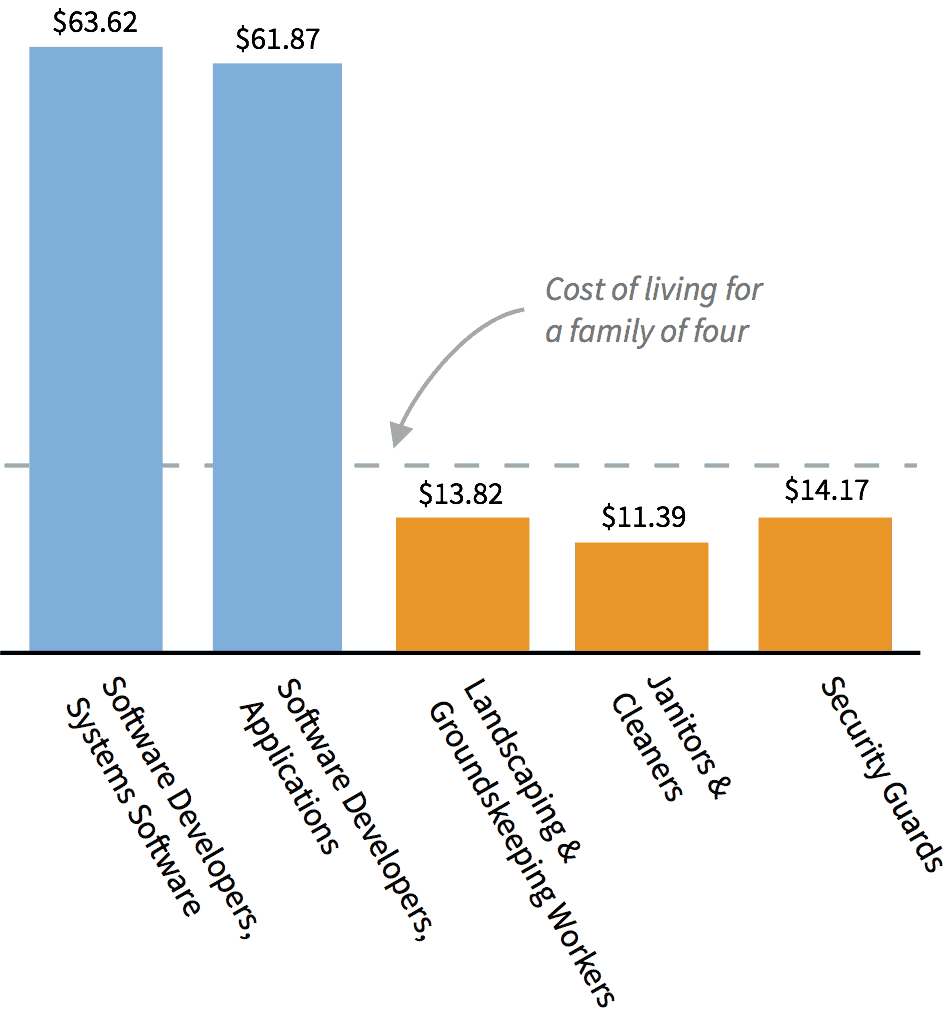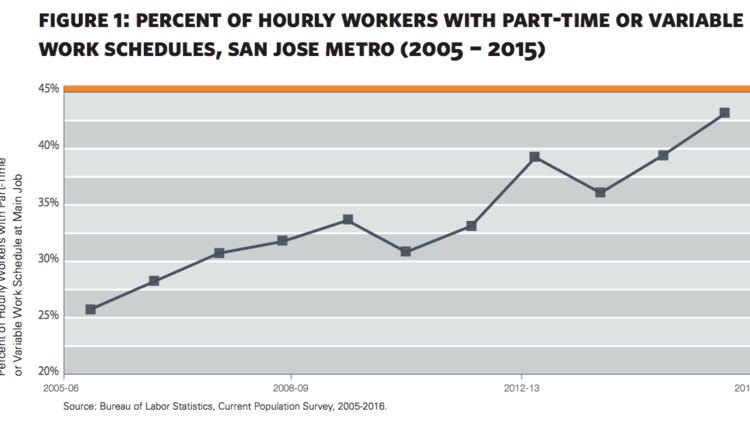Silicon Valley is a region of sharp contrasts:
● The region's top tech firms made a record $103 billion in profits in 2013.
● One in three Silicon Valley households do not make enough money to meet their most basic needs.
● There are well-compensated tech employees (although already-wealthy venture capitalists receive most of the gains).
● But a huge portion of the people who work at Silicon Valley tech firms are grossly underpaid "contractors" and part-timers.

Part-Timer Poverty
Many employers put a limit on the hours employees can work in a week. This keeps those employees from qualifying for any benefits that full-time employees get. They hire new part-time employees instead of moving employees they already have up to full-time. This is one of so many things that keeps people in poverty.
A 2014 CNN.com report, "Part-time jobs put millions in poverty or close to it," told the story:
Overall U.S. unemployment has fallen steeply in the past year (from 7.2 percent in October 2013 to 5.8 percent in October 2014), but too many people can only find part-time positions.
The number of people working part-time involuntarily is more than 50 percent higher than when the recession began.
[ ...] People in part-time jobs are five times more likely than full-time workers to live in poverty. About 75 percent of part-time workers either live in poverty or are low income, according to a report by Rebecca Glauber, a professor at the University of New Hampshire.
There is also a strong connection between unemployment and part-time work. Often these jobs don't last long.
"They're extremely economically vulnerable," says Glauber. "There's a real worry about those who are employed in relatively low quality, part-time positions."
Since that report was published, there has been a significant drop – 1.3 million in two years – in the number of people nationwide who are working part-time jobs even though they want to work full-time. Nonetheless, there are still more than 6 million people nationwide who fall into that category, according to the Bureau of Labor Statistics.
In Silicon Valley, this is a real problem. According to a report from The Center for Popular Democracy (CPD), Working Partnerships USA and The Fair Workweek Initiative, "A Hidden Crisis: Underemployment In Silicon Valley's Hourly Workforce":
● Among the estimated 162,000 people employed in hourly jobs in San Jose, the portion who have part-time or variable schedules at their main job has grown in the last 10 years from 26 percent to 43 percent, meaning more than four out of every ten hourly workers do not have full-time work at their primary job.
● Today, roughly 64,000 working people in the city of San Jose – overwhelmingly comprising women, people of color, and immigrants — do not have full-time work at their primary job.
● Sixty-three percent of hourly part-time workers are women and 69 percent are people of color.
The Opportunity to Work Initiative
Representatives of the Silicon Valley region's workers, faith, community and labor leaders will gather on Tuesday morning at the San Jose City Hall Rotunda (outside) to present more than 35,000 signatures for the Opportunity to Work ballot initiative. (The initiative only needed 20,000 to make it onto the November ballot.) Religious leaders will bless the petitions and the workers who are taking the petitions to the San Jose City Clerk’s office.
The Opportunity to Work Initiative would require employers to offer more hours to current and qualified hourly employees before hiring any new ones. This means employees would be able to start getting enough work hours to actually make a living, which would help approximately 64,000 hourly employees.
Very simple. Very to-the-point. Very badly needed.
This initiative comes from the Silicon Valley Rising coalition of labor, faith, community-based organizations and workers. It is led by Working Partnerships USA and the South Bay AFL-CIO Labor Council.
See also:
● "Silicon Valley Rising Fights To Give Part-Timers “Opportunity to Work”"
● "Important Study Looks At Silicon Valley’s “Invisible” Low Wage Workers"


